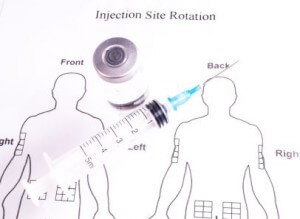We all know the health reasons behind changing your lancet and keeping sterile needles for insulin. But why should it matter where on your body you inject? In actuality, where you inject your insulin and how often you inject it there can have some considerable impacts on the rate of insulin absorption and changes in skin texture around the injection site. The best way to avoid complications from over-injecting in the same place is to constantly change where you inject and use a system of injection site rotation.
One major motivator for alternating your insulin injection spots is to avoid lipohypertrophy – the accumulation of fat cells under the skin. When the tissue thickens, lumps of fat can form around the injection site and can slow the absorption of insulin into your blood stream by as much as 25%[1]. Another side effect is liposatrophy, where the fat beneath the skin’s surface becomes depleted and can give a dimpled appearance. While these conditions (collectively known as lypodystrophy) are not life threatening, they can result in less stable blood glucose levels since an increase of insulin resistance can occur at the injection site and may require higher doses of insulin over time.
Where you inject also matters because different parts of your body intake the insulin differently. The most sensitive and fast absorbing area is your stomach and decreases in the rate of insulin uptake in the arms, then legs, and buttocks. When you are injecting for fast acting or slow release insulin you’ll want to take this into consideration. If you need an insulin dose before you hit the gym or take that evening jog, it is best to avoid injecting in the arm or thigh as the increase in blood flow to these areas can speed up the insulin absorption. Whether you are new to insulin injections or an old pro, testing post-insulin injection to understand more accurately how each site and activity affects your blood glucose monitoring. This is a great source of data for improved diabetes management
Don’t leave your injection sites to a wheel of fortune and plan ahead for your insulin injection rotation. When possible keep each of your daily injections to the same region and rotate around that area. For instance, if your morning insulin is placed in the abdomen on Tuesday on your left side, then your morning injection for Wednesday should be on the right side of your belly – not in your arm.

Take it a step further and map out your injection sites. As most people inject into the abdomen, let’s start here. You can divide your belly in 4 quadrants and divide those areas in to even smaller areas, rotating in each part in a circular method keeping each injection 2 – 3 cm from your last injection and being careful to avoid any scars or the area near your belly button. Move on to injecting in another quadrant the following week. This same mapping and can be used on other areas for injection. You can keep track of this in a journal or use your Dario app to document where you last injected along with the dose and type of insulin. As always, we recommend reviewing any plan or change with your doctor. Constantly needing to inject yourself can literally be a pain. But keeping a routine for rotating your insulin injection sites can prevent complications and help keep your blood sugar levels more consistent over time, making living with diabetes a little bit easier.
Medical Disclaimer
The articles provided on this website are for informational purposes only. In addition, it is written for a generic audience and not a specific case; therefore, this information should not be used for diagnostic or medical treatment. This site does not attempt to replace the patient-physician relationship and fully recommends the reader to seek out the best care from his/her physician and/or diabetes educator.